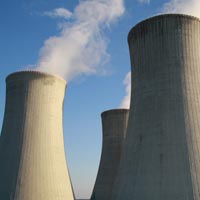
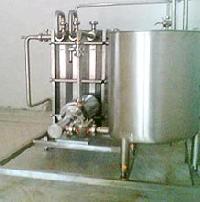


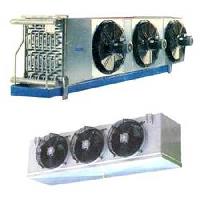

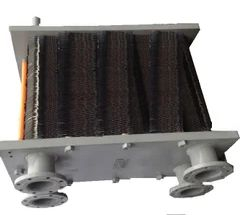
Plate Heat Exchanger
15,000 Per Piece
1 Piece (MOQ)

Plate Heat Exchanger
Get Price Quote
Best Deals from Plate Heat Exchangers
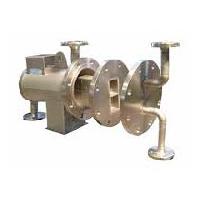
Conventional Plate Heat Exchanger
Get Price Quote
We are among the leading Manufacturers, Suppliers and Exporters of Conventional Plate Heat Exchanger to the esteemed clients. These Conventional Plate Heat Exchangers are available in various types� Water Jacket Type, Fins Type and U Tube Type. These Conventional Plate Heat Exchangers are suited for aviation and aerospace applications, including engine cooling. These Conventional Plate Heat Exchangers are procured from reliable Vendors in the market and advanced technology. These Conventional Plate Heat Exchangers are available at competitive rates in the market. A Plate Type Heat Exchanger is a type of Heat Exchanger that uses metal plates to transfer heat between two fluids. This has a major advantage over a Conventional Heat Exchanger in that the fluids are exposed to a much larger surface area because the fluids spread out over the plates. This facilitates the transfer of heat, and greatly increases the speed of the temperature change. It is not as common to see Plate Heat Exchangers because they need well-sealed gaskets to prevent the fluids from escaping, although modern manufacturing processes have made them feasible. Technical Data Heat exchange surface per plate : 0. 04 � 2. 50 m²Max. Design pressure : 25 barMax. Design temperature : 170oCPlate Material : 304, 316L, 310S, 254MO, C-276, TA1, N6 Applications Heat Exchangers are suited for aviation and aerospace applications including engine coolingIn automotive or industrial truckFor heating and cooling water for domestic purpose (e.g. swimming pools, snow melting, and boilers)Designed to cool electronic components that generate high amount of heat (CPUs, Lasers, and Transformers)In food, Dairy and brewing industriesFor heating, ventilation and air conditioning (HVAC) applicationsFor Heating and cooling of hydraulic power fluidFor Oil heating and cooling applicationsSuited for marine or shipboard applicationsSuited for power generation applicationsFor compressed air and are designed for use in pneumatic systemsFor use with refrigerants in cooling systemsSuited for applicants that involve the transfer of heat to and from steamOther unlisted or specialized applications

GASKETED PLATE & FRAME HEAT EXCHANGER
Get Price Quote
The Gasketed Plate & Frame Type Heat Exchanger that are made by us are premium in quality which is made using the best variety of raw materials. This plate heat exchanger is corrosion resistant and can easily be installed anywhere. Plate and frame heat exchangers comes in a compact design that assures greater efficiency, low hold-up volume, expandability and flexibility, easy maintenance, and close temperature approaches. Typical Applications HVAC Refrigeration Food, Beverage & Dairy Process Systems Sanitary Plate Heat Exchangers

Plate Heat Exchanger
Get Price Quote
10 Piece (MOQ)
Plate Coolers bolted Unique and maintenance-free – for efficient cooling The bolted plate coolers offer an economical solution for hydraulic systems and cooling circuit.s With their high cooling capacity and extremely low water consumption. The high turbulent flow of the fluid reduces the risk of soiling. Our coolers have been designed for operating pressures of 10 to 16 bar. For applications, where the medias should not get mixed, we recommend the solution with double wall plates. We can also supply you with customised solutions with switch over devices.
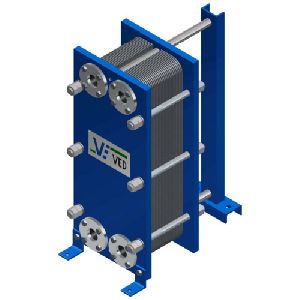
Plate Heat Exchanger
Get Price Quote

Brazed Plate Heat Exchanger
150 - 5,000 Per kg

Plate Heat Exchanger
Get Price Quote
Function of Plate Heat ExchangersThe plates are fitted with a gasket which seals the channel and directs the fluids into alternate channels. The number and size of the plates are determined by the flow rate, physical properties of the fluids, pressure drop and temperature program. The plate corrugations promote fluid turbulence and support the plates against differential pressure. The plates and the pressure plate are suspended from an upper carrying bar and located by a lower guiding bar both of which are fixed to the support columns.Connections are located in the frame cover, or if either or both fluids make more than a single pass within the unit, the frame and pressure plates. We are in the process of developing the Plate Heat Exchanger and would take up the manufacturing in the near future.The plate heat exchanger consists of a pack of corrugated metal plates with portholes for the passage of the two fluids between which heat transfer will take place. The plate pack is assembled between a frame plate and a pressure plate and compressed by tightening bolts.Applications : Lube Oil Coolers Steam Heaters Jacket Water Coolers Water Heaters (non-electrical) Fuel Oil Heaters Gearbox Oil coolers Equivalent to other Heat ExchangersIf you are unhappy with the original design of plate heat exchangers, send us the operating specifications and improvements required and we will offer a suitable replacement heatexchangers. We can also provide a shell and tube equivalent, if you would prefer to have a unit that is more easily repaired on our factory.

Brazed Plate Heat Exchanger
Get Price Quote
Brazed Plate Heat Exchangers represent the most compact, rugged and cost-effective means of transferring heat in many industrial and refrigerant applications. The SB-Series features corrugated plates that produce highly turbulent flow in a true counter-current direction. Built from 316 stainless steel with copper brazing materials, they provide exceptional corrosion resistance.

Plate finned type Heat Exchanger
Get Price Quote
Plate finned type Heat Exchanger of flexibility is present in plate-fin heat exchanger design as they can operate with any combination of gas, liquid, and two-phase fluids.

Plate Heat Exchanger
65,000 Per Units

Brazed Plate Heat Exchanger
Get Price Quote
We provide high quality Compact design Three way design for heat pumps Higher Heat Transfer High corrosion resistance Low investment costs for BPHE Simplify maintenance and repair with BPHE Versions for standard and high pressure operation

Plate Type Heat Exchanger
Get Price Quote
Plate heat exchangers have a high heat transfer rate compared to other types of heat exchangers due to their large surface area. They are composed of a number of thin metal plates compressed together into a ‘plate pack’ by two pressure plates. Within a plate heat exchanger, the fluid paths alternate between plates allowing the two fluids to interact, but not mix, several times in a small area. Each plate is corrugated to increase the surface area and maximize heat transfer. plate heat exchangers have a number of applications in the pharmaceutical, petrochemical, chemical, power, industrial dairy, and food & beverage industry.

Plate Fin Heat Exchanger
Get Price Quote
We are offering Plate fin heat exchanger is one of the most efficient compact heat exchanger. The gaps between constitute a fluid layer. A core is made of a great number of layers. The exchanger can be made of one or more cores. The number of plate and fin layers, the size of the plates and fin, the height of the fin and the type of fin are engineered for optimum performance. The core is assembled (stacked) and typically held together by tack welding a weld rod to the top and bottom layer of the core. The stacked core is then placed within a fixture that exerts force on the individual pieces to keep them in contact. The part is then vacuum brazed in an environmentally-controlled room to ensure high quality and reliability. After brazing the core is typically heat treated or aged in order to increase its strength. Manifold ducting and mounting brackets are then welded in place as required, and any required paint or coating can be added.

Plate Heat Exchanger
65,000 Per unit

Plate Heat Exchanger
Get Price Quote
We are counted among the most prominent Plate-Type Heat Exchanger Exporters from Tamil Nadu. Our Plate Heat Exchanger comprises of various corrugated metal plates with holes between the two fluids through which transfer of heat can take place. Herein, the sizes and number of the plates are determined by the physical properties of the fluids, flow rate, temperature program, and pressure drop. With efficient manufacturing capabilities, we are able to offer customized designs of Industrial Plate Heat Exchanger as per the need of the client.

Plate Heat Exchanger
25,000 Per Piece

Plate Heat Exchanger
Get Price Quote
We manufacture and supply world class Plate Heat Exchanger that is widely used in different industrial processes in industries like dairy, milk processing units, HTST pasteurizing facilities, etc. The durability and strength of our exchangers make us the foremost Plate Heat Exchangers manufacturers and suppliers from Coimbatore, Tamil Nadu. Operation : Our Heat Exchangers use metal plates to transfer heat between two liquidsThen the liquids are exposed to a much larger surface area, as the liquids spread out over the plate.This further facilitates the transfer of heat and increases the speed of the temperature change. Widely Used For : Milk ProcessingIce Cream manufacturingChurning of Butter MilkHTST Pasteurizing

Plate finned type Heat Exchanger
Get Price Quote
We are the leading manufacturers of Plate finned type Heat Exchanger in India. PFHE are Classified based on the Application : 1. Refrigeration Condensers2. Air Coolers3. Air Heaters4. Steam Condensers5. Compressor Inter cooler and After coolers Oil refineries, Power Plants, Food Industries and Processing Industries are mainly using the Plate Finned Type Heat Exchangers for Condensation and Refrigeration purpose. Material of Construction : 1. Copper Tubes2. Aluminum Fins or Foils3. Copper Alloy tubes4.Carbon steel Casings5. Stainless steel casings Air Heater using blowers and Ducting system Air Heaters and Air coolers : The ultimate use of Plate finned Heat Exchangers are Air cooling and Air heating. Here the Air to be cooled or Heated is flows through the Fin side. i.e Air flows across tubes. And Cooling or Heating medium is passes through the tubes. i.e Steam or refrigerant. Heaters : When Cold Air comes from the system (or) Atmosphere it passes across the tubes, Tubes carrying of Hot Fluid (or)Steam will comes enters in to tubes. Due to temperature difference between the both sides. Heat gets transfers from Hot fluid to cold fluid through conductive tubes. The Required heat transfer area to achieve the Heating of air to required temperature is arrived using the standard Heat duty relations. The flow of Air may be forced or Induced flow based on application. Heat Lost by Hot fluid = Heat gain by Cold fluid Air coolers :: In the same way of Heating, Air coolers also working in the same principle. Here tubes will carry the cold fluid. i.e Refrigerant. Due to temperature difference between the both sides. Heat gets transfers from Hot fluid to cold fluid through conductive tubes. The Required heat transfer area to achieve the Heating of air to required temperature is arrived using the standard Heat duty relations. Air will pass the Heat to the Refrigerant, Based on the LMTD between the fluids. In maximum cases the Air is sucked from the atmosphere using the air blowers and filters. Features: For Quality Fins we use Virgin 1100 grade aluminum. As per the ASTM B280 Standards Internal Cleaning System for Coil are designed. We tested our coil at 400 PSI of dry nitrogen pressure. A Plate finned type Heat Exchanger is the most common type of heat exchanger in all manufacturing Industries. To know the plate fin heat exchanger cost mail us your requirements.
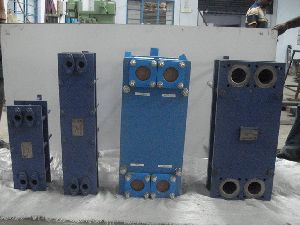
Plate Type Heat Exchanger
Get Price Quote
A plate type heat exchanger is a type of heat exchanger that uses metal plates to transfer heat between two fluids. This has a major advantage over a conventional heat exchanger in that the fluids are exposed to a much larger surface area because the fluids spread out over the plates. This facilitates the transfer of heat, and greatly increases the speed of the temperature change. It is not as common to see plate heat exchangers because they need well-sealed gaskets to prevent the fluids from escaping, although modern manufacturing processes have made them feasible. The concept behind a heat exchanger is the use of pipes or other containment vessels to heat or cool one fluid by transferring heat between it and another fluid. In most cases, the exchanger consists of a coiled pipe containing one fluid that passes through a chamber containing another fluid. The walls of the pipe are usually made of metal, or another substance with a high thermal conductivity, to facilitate the interchange, whereas the outer casing of the larger chamber is made of a plastic or coated with thermal insulation, to discourage heat from escaping from the exchanger. The plate heat exchanger (PHE) was invented by Dr Richard Seligman in 1923 and revolutionized methods of indirect heating and cooling of fluids. Plate type heat exchanger one is composed of multiple, thin, slightly-separated plates that have very large surface areas and fluid flow passages for heat transfer. This stacked-plate arrangement can be more effective, in a given space, than the shell and tube heat exchanger. Advances in gasket and brazing technology have made the plate-type heat exchanger increasingly practical. In HVAC applications, large heat exchangers of this type are called plate-and-frame; when used in open loops, these heat exchangers are normally of the gasket type to allow periodic disassembly, cleaning, and inspection. There are many types of permanently-bonded plate heat exchangers, such as dip-brazed and vacuum-brazed plate varieties, and they are often specified for closed-loop applications such as refrigeration. Plate heat exchangers also differ in the types of plates that are used, and in the configurations of those plates. Some plates may be stamped with “chevron” or other patterns, where others may have machined fins and/or grooves. Specifications : Liquid foods such as milk, fruit juices, beers, wines, and liquid eggs are pasteurized using plate-type heat exchangers. Wine and fruit sjuices are normally deaerated prior to pasteurization in order to remove oxygen and minimize oxidative deterioration of the products. Plate-type heat exchangers consist of a large number of thin, vertical steel plates that are clamped together in a frame. Applications : The plates produce an extremely large surface area, which allows for the fastest possible transfer. Making each chamber thin ensures that the majority of the volume of the liquid contacts the plate, again aiding exchange. The troughs also create and maintain a turbulent flow in the liquid to maximize heat transfer in the exchanger. A high degree of turbulence can be obtained at low flow rates and high heat transfer coefficient can then be achieved. Advantages : Easy maintenance and suitable for CIP, plate pack easily accessible High heat transfer coefficients Flexibility to change plate arrangement and to add or remove plate No mixing of product Compact constructions Optimized heat recovery